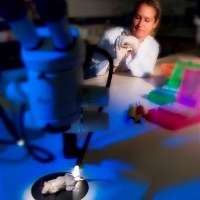Females fight back in sperm wars

(Phys.org) —Females exposed to a risk of sperm competition have been found to produce more defensive ova compared to the eggs of females reared under no risk of sperm competition, according to researchers at The University of Western Australia who studied house mice.
The world-first investigation - published today in Proceedings of the Royal Society B - provides the first account of a female trait in response to the risk of sperm competition, which is biologically costly for females because it may lead to infertility. The researchers are working to understand the mechanism by which the ova defend themselves against an onslaught of sperm.
The team has also provided the first example that females respond adaptively to the sperm competition environment, which allows them to prepare for prevailing conditions during their reproductive life.
Dr Renée Firman from UWA's Centre for Evolutionary Biology said it is well-known that the ejaculate of males changes according to their perception of sperm competition risk.
"In our study, we used in vitro fertilisation (IVF) to explore whether females have the capacity to respond to increased fertilisation effort among males by increasing their defenses against polyspermy."
The team sourced mice from two natural populations - one bred from a less competitive group and another from a more competitive group - and tested whether females could adaptively adjust their resistance to fertilisation in response to cues that corresponded to different sperm competition environments.
"We manipulated the experience of these females during their development to mimic a social environment of either a 'risk' or 'no risk' of sperm competition, which generated striking results," Dr Firman said.
The results will be of broad interest to evolutionary biologists and reproductive physiologists and may open up new avenues of research into the underlying mechanisms of sperm-ovum interactions, and identify crucial elements in the fertilisation process, particularly in relation to the ovum's block to polyspermy.
"More generally, we anticipate that our study will drive a new field of research examining female responses to variation in sperm competition risk and intensity," Dr Firman said.
More information: Sperm competition risk generates phenotypic plasticity in ovum fertilizability, rspb.royalsocietypublishing.or … .1098/rspb.2013.2097
Journal information: Proceedings of the Royal Society B
Provided by University of Western Australia


















